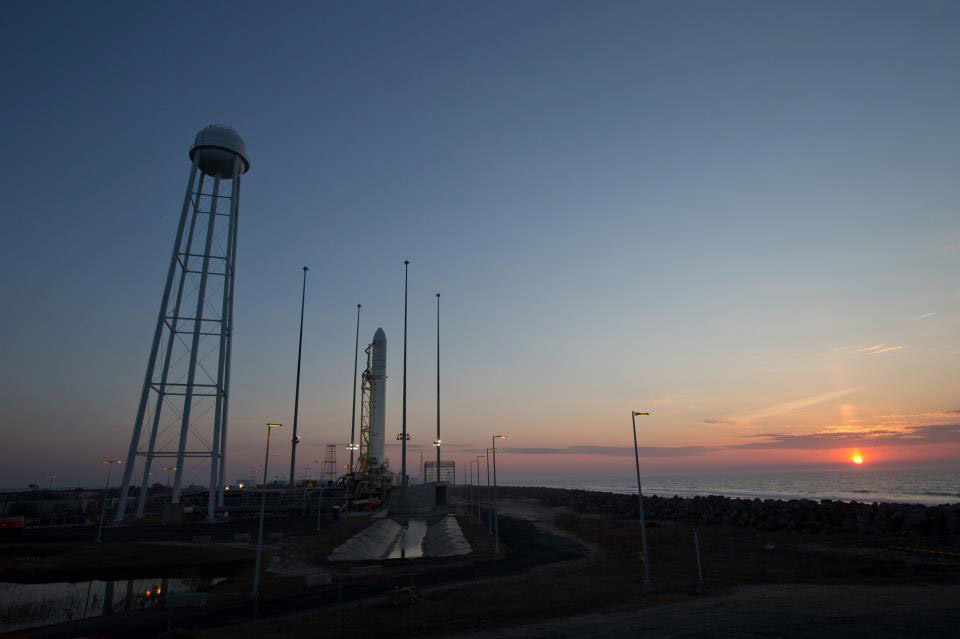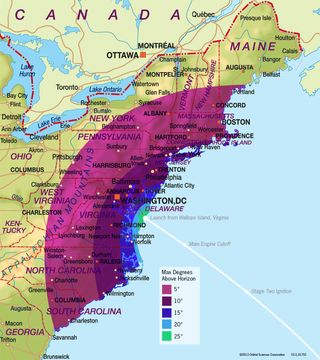New Private Rocket Cleared for Critical Launch Test Wednesday

WALLOPS ISLAND, Va. —The biggest private rocket ever to launch from Virginia's Eastern Shore is ready to take its maiden voyage on Wednesday (April 17), the rocket's builders say.
NASA and the commercial spaceflight company Orbital Sciences Corp. have officially cleared the company's new Antares rocket for launch, setting the stage for what will be a critical test flight from NASA's Wallops Flight Facility here. Liftoff is set for Wednesday at 5 p.m. EDT (2100 GMT).
"It's going to be the biggest, brightest and loudest thing ever launched from Wallops," Orbital executive vice president Frank Culbertson, a former NASA astronaut, told reporters today (April 16). "It's going to be visible up and down the East Coast." [How to see the Antares rocket launch]
You can watch the Antares rocket launch webcast on SPACE.com, courtesy of NASA.
The Antares rocket is a two-stage booster that stands 131 feet (40 meters) tall and is designed to launch Orbital's robotic Cygnus spacecraft on cargo delivery missions to the International Space Station. The Dulles-based Orbital Sciences has a $1.9 billion contract with NASA to provide at least eight cargo missions to the station. NASA picked Orbital Sciences as a commercial cargo provider in 2008.
With NASA's space shuttle fleet retired, the space agency is relying on commercial rockets and spacecraft to serve as the vital supply line for the space station. Another company, Space Exploration Technologies (SpaceX) of Hawthorne, Calif., has a $1.6 billion contract for 12 cargo missions under a similar deal.
SpaceX launches its rockets from Florida, which has a long tradition of space launches, and has already flown two delivery flights and one test mission under that program.
Get the Space.com Newsletter
Breaking space news, the latest updates on rocket launches, skywatching events and more!
"This does represent a new way of doing business for NASA," NASA's commercial crew program manager Alan Lindenmoyer said. "We're sharing the cost."
Orbital officials said the company began developing the Antares rocket on its own, and later received up to $288 million in NASA support to help develop the Cygnus craft. So far, Orbital has completed 24 of the 29 milestones required to receive that $288 million. The company also added in "several hundred million" of its own funds for Cygnus, Culbertson said.
Orbital is hoping that investment pays off not only in NASA contracts for station cargo missions, but also in deals with commercial customers who want to use Antares and Cygnus. But first, the Antares rocket must prove its spaceworthiness, and that's where Wednesday's test flight comes in.
Orbital's Antares rocket uses two Aerojet AJ26 liquid-fueled engines, modernized versions of a design originally developed to launch Russia's N-1 moon rocket in the 1960s, to power its first stage. The second stage is powered by a new solid rocket motor built by veteran solid-fueled motor builder ATK, which also built the boosters for NASA's space shuttles.
The Antares test flight will lift off from a brand-new launch pad, called Pad 0A, at the Mid-Atlantic Regional Spaceport, a commercial spaceport built at NASA's Wallops Flight Facility and overseen by the Virginia Commercial Spaceflight Authority. It's the first test for the launch pad, too.
According to Orbital officials, the test flight could be visible from as far north as Portland, Maine, and as far south as Charleston, S.C., weather permitting. It should definitely be visible as a bright light soaring southeastward across the sky from Washington, D.C., the home of Congress. Culbertson said he hopes lawmakers in Washington see the rocket launch.
"That's a new experience," Culbertson said. "People think you have to go to Florida to see a space launch."

The test flight will be the highest profile launch yet for the Wallops Flight Facility, which was established in 1945 as a center for aerodynamics research. Today, the facility is NASA's hub for small suborbital rocket launches and balloon science missions. More than 16,000 small rockets have been launched on short science missions since the facility became operational.
But Antares is the biggest rocket yet to reach the launch pad. NASA and Orbital officials made it clear that Wednesday's test flight was just that — a test — and one that could fail. Just making it to the launch pad was a feat in itself, they added.
"Regardless of whether it is a good day or a bad day, or something in between, for tomorrow…whatever happens, it's been a good job to get us where we are today," said Phil McAlister, NASA's director of commercial spaceflight development.
Editor's note: If you snap a great photo of Orbital's Antares rocket launch that you'd like to share for a possible story or image gallery, send photos, comments and your name and location to managing editor Tariq Malik at spacephotos@space.com.
Visit SPACE.com for complete coverage of the Antares rocket launch on Wednesday.
This story was corrected on April 17 to reflect the proper title of Orbital's Frank Culbertson, Executive Vice President and General Manager of Orbital's Advanced Programs Group.
Email Tariq Malik at tmalik@space.com or follow him @tariqjmalik and Google+. Follow us @Spacedotcom, Facebook and Google+. Original article on SPACE.com.
Join our Space Forums to keep talking space on the latest missions, night sky and more! And if you have a news tip, correction or comment, let us know at: community@space.com.

Tariq is the Editor-in-Chief of Space.com and joined the team in 2001, first as an intern and staff writer, and later as an editor. He covers human spaceflight, exploration and space science, as well as skywatching and entertainment. He became Space.com's Managing Editor in 2009 and Editor-in-Chief in 2019. Before joining Space.com, Tariq was a staff reporter for The Los Angeles Times covering education and city beats in La Habra, Fullerton and Huntington Beach. In October 2022, Tariq received the Harry Kolcum Award for excellence in space reporting from the National Space Club Florida Committee. He is also an Eagle Scout (yes, he has the Space Exploration merit badge) and went to Space Camp four times as a kid and a fifth time as an adult. He has journalism degrees from the University of Southern California and New York University. You can find Tariq at Space.com and as the co-host to the This Week In Space podcast with space historian Rod Pyle on the TWiT network. To see his latest project, you can follow Tariq on Twitter @tariqjmalik.